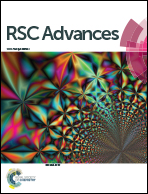Facile colorimetric detection of 6-benzylaminopurine based on p-aminobenzenethiol functionalized silver nanoparticles
Abstract
A simple colorimetric assay has been developed to detect 6-benzylaminopurine (6-BA) in a complex environment by using the novel probe p-aminobenzenethiol functionalized silver nanoparticles (ABT-AgNPs). When ABT-AgNPs bind with 6-BA, a huge conjugate network can form based on intense electrostatic effects, hydrogen bonding and π–π stacking interactions, resulting in a visible colour change from faint yellow to reddish orange. The interactions between the 6-BA and ABT also were validated by the density functional theory (DFT) approach. The influence of experimental conditions on the analytical performance was investigated systematically. Under optimal conditions, the absorbance ratio (A510 nm/A397 nm) is linearly related to the logarithm of 6-BA concentration from 1 μM to 20 μM, with a detection limit of 0.1 μM. Furthermore, no obvious interference was observed from common inorganic ions and other pesticides. 6-BA was also successfully determined in samples with complicated matrices. The recoveries obtained from water and vegetable samples were in the range ∼81.3–101.2%.


 Please wait while we load your content...
Please wait while we load your content...